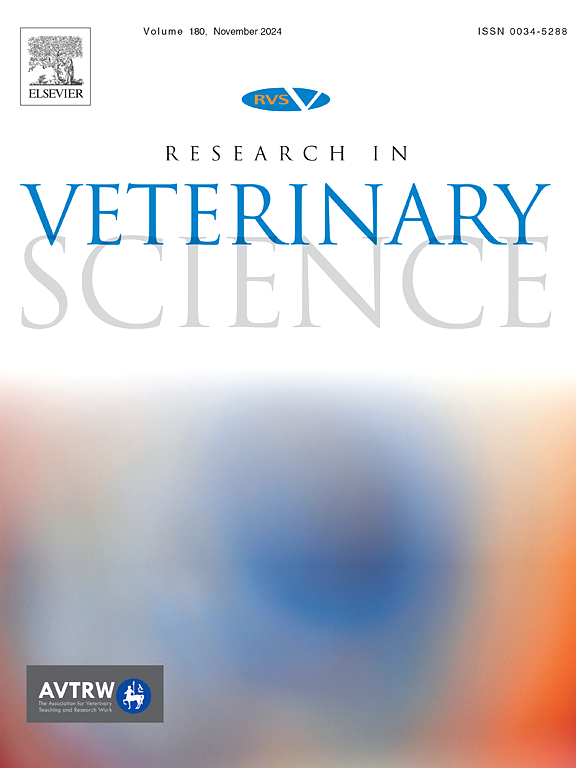Altered expression of collagen gene family members and its epigenetic background in equine Sarcoids
IF 2.2
3区 农林科学
Q1 VETERINARY SCIENCES
引用次数: 0
Abstract
Alterations in the genes involved in the creation of the extracellular matrix (ECM) were observed in our earlier transcriptome studies of sarcoids and their cell culture model. For a complete characterization of the underlying molecular pathways, it is imperative to comprehend the involvement of ECM modifications in the oncogenic transformation of sarcoid fibroblasts. Thus, the aim of this investigation was to describe the expression patterns of a set of genes that are essential for the rearrangements of the extracellular matrix, namely collagen genes, and elucidate possible mechanisms underlying the observed disruptions. To this end, we applied the RT-qPCR method on BPV-negative skin samples and sarcoid samples (n = 6 and 7; respectively) to perform relative quantification of the expression level of eight genes belonging to the collagen family and carried out an integrative analysis of the obtained data with previously characterized epigenetic signatures. The results showed aberrations in the level of chosen collagen genes in the sarcoids compared to the control, manifesting in their elevated levels in the tumor samples (p-value≤0.05). The upregulation of Col1A2, Col11A1, Col6A3, Col5A2, Col4A1, Col6A6, Col5A1, Col6A2 genes was detected in sarcoid samples. The identified changes were statistically significant (p-value≤0.05) and ranged from 1.43 (Col6A2) to 1.88 (Col6A3). Further investigation into the potential involvement of epigenetic mechanisms in the regulation of collagen gene levels in sarcoids revealed compelling evidence of DNA methylation and microRNAs playing significant roles. The findings suggest a complex interplay between gene expression, epigenetic regulation, and the dysregulation of the ECM in sarcoid pathogenesis.
马肉瘤中胶原基因家族成员表达的改变及其表观遗传背景
在我们早期对肉瘤及其细胞培养模型的转录组研究中,观察到参与细胞外基质(ECM)形成的基因发生了变化。为了完整地描述潜在的分子途径,有必要了解ECM修饰在肉瘤成纤维细胞的致癌转化中的作用。因此,本研究的目的是描述一组基因的表达模式,这些基因对细胞外基质的重排至关重要,即胶原蛋白基因,并阐明观察到的破坏的可能机制。为此,我们将RT-qPCR方法应用于bpv阴性皮肤样本和肉瘤样本(n = 6和7;分别)对属于胶原蛋白家族的8个基因的表达水平进行相对量化,并将获得的数据与先前表征的表观遗传特征进行综合分析。结果显示,与对照组相比,肉瘤中所选胶原基因的水平出现畸变,表现为肿瘤样本中所选胶原基因的水平升高(p值≤0.05)。在肉瘤样品中检测到Col1A2、Col11A1、Col6A3、Col5A2、Col4A1、Col6A6、Col5A1、Col6A2基因的上调。鉴定的变化具有统计学意义(p值≤0.05),变化范围为1.43 (Col6A2) ~ 1.88 (Col6A3)。对肉瘤中胶原基因水平调控的潜在表观遗传机制的进一步研究揭示了DNA甲基化和microrna发挥重要作用的令人信服的证据。研究结果表明,在肉瘤发病机制中,基因表达、表观遗传调控和ECM失调之间存在复杂的相互作用。
本文章由计算机程序翻译,如有差异,请以英文原文为准。
求助全文
约1分钟内获得全文
求助全文
来源期刊

Research in veterinary science
农林科学-兽医学
CiteScore
4.40
自引率
4.20%
发文量
312
审稿时长
75 days
期刊介绍:
Research in Veterinary Science is an International multi-disciplinary journal publishing original articles, reviews and short communications of a high scientific and ethical standard in all aspects of veterinary and biomedical research.
The primary aim of the journal is to inform veterinary and biomedical scientists of significant advances in veterinary and related research through prompt publication and dissemination. Secondly, the journal aims to provide a general multi-disciplinary forum for discussion and debate of news and issues concerning veterinary science. Thirdly, to promote the dissemination of knowledge to a broader range of professions, globally.
High quality papers on all species of animals are considered, particularly those considered to be of high scientific importance and originality, and with interdisciplinary interest. The journal encourages papers providing results that have clear implications for understanding disease pathogenesis and for the development of control measures or treatments, as well as those dealing with a comparative biomedical approach, which represents a substantial improvement to animal and human health.
Studies without a robust scientific hypothesis or that are preliminary, or of weak originality, as well as negative results, are not appropriate for the journal. Furthermore, observational approaches, case studies or field reports lacking an advancement in general knowledge do not fall within the scope of the journal.
 求助内容:
求助内容: 应助结果提醒方式:
应助结果提醒方式:


